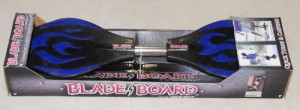Buying for parts alone?
Back here I covered how, when I first started to design my Air 150 recumbent trike , I spent a lot of time looking for the lightest possible springs.
I tried rubber springs (in torsion, shear and compression), carbon fibre, elastomers and others.
My initial desire was to use torsion bars, preferably made from spring steel. However, I gave up on doing this for a number of reasons – weight, stress level in the steel (best addressed by using multiple leaves, Volkswagen Beetle style), and the difficulty in fastening the ends of the bar without introducing even higher stresses.
And the Firestone air-springs I chose to use in the final design are still my pick for springs in ultra light-weight vehicles.
But the other day I came across a product that might have changed the situation. It’s a type of skateboard that uses two wheels, mounted in line. The two halves of the board can pivot relative to one another around a longitudinal axis, and the two wheels can rotate, castor style.
I bought mine (branded “Blade Board”) from Target for AUD$50.
I wanted it for the polyurethane wheels, mounted on very nice alloy die-cast castors and using sealed bearings for the wheel axles and the castor pivots. (And the castor bearings pivot on very strong, hardened steel shafts!)
But I also found that inside the steel tube that joins the two halves of the board is a torsion bar. It uses four steel laminations. Alloy end-fittings are cast over the steel laminations, providing easy attachment.
I’ve put one in the vice and torsionally loaded the other end – and it works very well. The rate (ie stiffness) isn’t enormously high, but probably enough for short leverage ratio suspension on a human powered vehicle.
In fact, while the Blade Board is not quite worth buying just for the torsion bar (not unless you have an immediate use for it), by the time you add in four surplus small diameter sealed ball bearings (they’re not needed in most non-Blade Board applications), the very strong polyurethane castor wheels with full bearings, and a few odds and ends (springs, stainless steel bolts), they’re almost worth buying for the parts alone.
On special, they certainly would be!

 Julian Edgar, 50, has been writing about car modification and automotive technology for nearly 25 years. He has owned cars with two, three, four, five, six and eight cylinders; single turbo, twin turbo, supercharged, diesel and hybrid electric drivelines. He lists his transport interests as turbocharging, aerodynamics, suspension design and human-powered vehicles.
Julian Edgar, 50, has been writing about car modification and automotive technology for nearly 25 years. He has owned cars with two, three, four, five, six and eight cylinders; single turbo, twin turbo, supercharged, diesel and hybrid electric drivelines. He lists his transport interests as turbocharging, aerodynamics, suspension design and human-powered vehicles.




on March 12th, 2009 at 8:56 am
Did you try out riding the blade board?
on March 12th, 2009 at 9:57 am
No I didn’t! I have a bad knee that pops out of joint if I twist my leg, and the potential agony + 3 days without being able to walk didn’t seem worth it…
on March 13th, 2009 at 10:33 am
I think they were a particularly popular christmas present for children this year- they’re very common on the local boardwalk near us. They seem to be a particularly inefficient form of locomotion- the child has to create quite a lot of lateral movement and swivelling motion to get the thing moving, and they don’t seem to glide far.
on March 13th, 2009 at 12:07 pm
@ Paris: they do you can actually ride them properly. (neighbours have street luge on them)